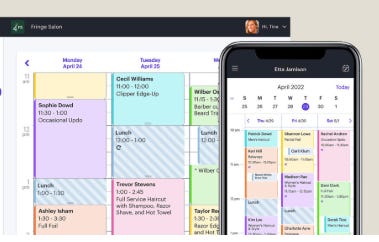Technology and Tools for IECs: From Overwhelm to Optimization
Tech can drive the new IEC office... but only if used correctly.
When I started at IECA three decades ago, the most pressing “tech” decision facing consultants was whether to organize client files in a metal cabinet or a milk crate. I remember an early debate about whether it was ever appropriate to use email to communicate with parents.
Today, we’ve moved light years ahead—but with progress has come complexity. As the profession has grown, the tools available to Independent Educational Consultants (IECs) have exploded, offering new ways to manage client relationships, streamline tasks, and better project student outcomes. And yet, time and again, I hear from consultants:
“I’m drowning in systems. Do I NEED this new software? I don’t even know what I really need. I get so frustrated that my apps are taking time away from actually advising my students.”
This post is for those IECs. Because the goal of technology shouldn’t be to add to our workload—it should help us reduce friction, reclaim time, and better serve families.
This is the third entry in my five-part series exploring the hidden frustrations I see among IECs:
🔗 The Hidden Frictions in Educational Consulting
The IEC Tech Explosion: A Double-Edged Sword
Today’s IEC might use a client relationship management (CRM) platform, essay review software, a scheduling app, multiple research tools, parent communication systems, collaborative editing platforms, and various messaging channels. Each tool may serve a unique function, but if they don’t work in harmony—or if we’re unsure how best to use them—they can lead to inefficiency, frustration, and even burnout.
The result? Many consultants either over-invest in tech that doesn’t fit their needs or under-utilize tools that could dramatically improve their workflow.
What Should Be in Your Tech Stack?
Let’s walk through the core categories most IECs encounter, along with practical considerations and reflections.
1. Client Relationship Management (CRM)
Newer IECs, especially those with fewer than 10 clients, may not see the immediate value of a CRM. If you plan to remain small, it can make sense to forgo the investment. But if you envision growth, the best time to adopt a system is before you get busy. That gives you time to master its features and build it into your practice.
For many, CRMs are the backbone of an organized business. They help track student progress, log communications, send forms, and provide family portals.
What to Look For: Ease of use, customization, calendar sync, family/student access
Watch Out For: Feature overload. Some consultants opt for big-name CRMs with high price tags and tons of features, then end up using only 10%. If that’s the case, it might be time to downsize.
Mark’s Thoughts: Don’t try to implement a new CRM during application season. The busier you are, the harder it will be to learn the system. Instead, mark your calendar from January to April to research, purchase, and get up to speed. Also remember: you're not just buying software—you’re buying a support team. Ask around to find out which companies offer responsive, helpful service when you need it.
2. Scheduling & Time Management
Automated scheduling cuts down on back-and-forth emails and protects your personal time. I’ve had IECs tell me that just a few years ago, they dreaded sending an email to request a meeting, knowing it would result in a dozen follow-ups before a date could be agreed upon (and likely rescheduled).
Popular Tools: Calendly, Acuity, YouCanBookMe
Mark’s Thoughts: New consultants sometimes think they don’t need scheduling software until they get busy. Nonsense! A scheduling app allows you to appear to have a thriving business and protect your time. Block out your book club, your morning yoga, your admin time—no one needs to know. It communicates professionalism while keeping you sane.
Always leave buffer time between meetings to jot down notes, grab a snack, or breathe. During slower seasons, block out entire days—that’s the joy of being self-employed. And don’t forget to sync with your personal calendar to avoid double-booking (something I still forget occasionally myself!).
3. Essay Collaboration
This is one of the most nuanced—and potentially problematic—areas. Collaboration tools can help with brainstorming, version tracking, and deadline management. But they must preserve student voice.
Popular Tools: Google Docs, Prompt, Draftback, and emerging AI platforms
Mark’s Thoughts: Be crystal clear with students and families from the start about the essay process, including the role of “Uncle Albert,” the English teacher, the IEC, and technology. “Ghostwriting creep” is real: each draft can gradually take on the adult’s voice if not carefully managed. The student’s authenticity must remain at the center.
4. College Research and Planning Tools
These platforms provide access to college profiles, admission stats, scattergrams, and more.
Popular Tools: SCOIR, MaiaLearning, College Kickstart, BigFuture
Mark’s Thoughts: These are helpful tools—but not shortcuts to decision-making. Your job is to provide context. That means explaining what admission rates mean, how scattergrams should be read, and why fit—not prestige—is the “secret sauce.” Success isn’t about getting into the most selective school; it’s about thriving in the right one.
5. Communication Tools
IECs need to balance accessibility with boundaries. Should you text with students? Should you train them to use email, which they'll need for applications? Tools like Zoom, Loom, Slack, and templated emails can streamline your work—but only if you set expectations early.
Mark’s Advice:
Set office hours for communication (including how late messages will be read/responded to).
Use templated replies to speed up FAQs.
And please—turn off notifications after hours. Burnout is real, and boundaries protect you and avoid frustrated clients.
6. Marketing, Outcome Tracking, and Data Analytics
Most IECs want to track outcomes and marketing success, but don’t. And that’s a missed opportunity.
Why It Matters:
You can measure your impact over time.
You can refine your strategies.
You can determine if your outreach is working.
Mark’s Advice:
Start simple. Even if response rates post-enrollment are low, asking for feedback before students head off can be valuable. Then follow up later to check how well their college or school matched their expectations.
Also, track your marketing:
How many webinar, presentation or PTA address attendees became clients?
How many inquiries convert after an info session?
If your numbers are underwhelming, you need to know why. Without data, you’re flying blind.
🧰 Mark’s Quick Tech Audit Checklist
✅ Does this tool solve a real problem I face regularly?
✅ Am I using most of its features?
✅ Do I know how much I’m paying—and is it worth it?
✅ Does this integrate with my other systems or create extra work?
✅ Have I asked peers what they use—and why?
✅ Have I trained my clients (and myself) to use it effectively?
✅ Does this tool enhance—rather than diminish—my advising style?
Conclusion: Technology Should Serve You—Not the Other Way Around
The best tools are those that make you more efficient, more confident, and more connected to students. There’s no single magic platform—but with regular audits, thoughtful alignment, and a strong peer network, you can build a tech stack that fits your practice.
Notice I didn’t spend much time on AI? Trust me—it’s coming, and it will have its own article. Hit that (free) subscribe button so you don’t miss it.
Meanwhile, let’s keep the conversation going:
What tools have helped you thrive? Which ones weren’t worth the hype?
Drop a comment or reach out—I’d love to feature your insights in a future post.




We have been using GHL!